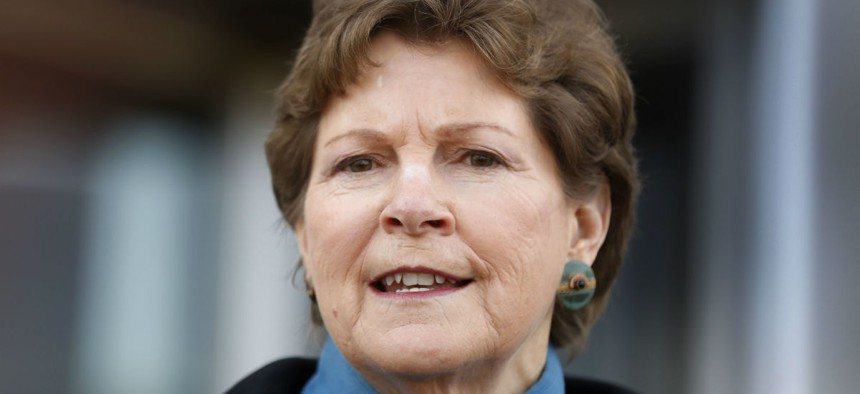
Sen. Jeanne Shaheen, D-N.H., is one of the senators who wrote a Nov. 15 letter to Secretary of State Rex Tillerson. Jim Cole / AP file photo
State Dept. Defends Management Reforms Against Senators' Complaints
McCain and Shaheen want more consultation with Congress on staff cuts.
Despite rising criticism from lawmakers, the State Department on Monday defended its approach to a still-unfolding reorganization plan that is likely to result in continuing cuts among Foreign Service officers.
The most recent complaint came in a Nov. 15 letter to Secretary Rex Tillerson from Sens. John McCain, R-Ariz., and Jeanne Shaheen, D-N.H., warning of their “deep reservations regarding management decisions” and a hiring freeze that they said would harm long-term diplomacy.
“The failure to replace losses from the ranks of the Foreign Service due to attrition and resignations with promotions and the recruitment of new entry-level officers appears to be intended to reduce staffing levels,” the senators wrote. “To date, however, Congress has not been consulted on the rationale for these decisions, or the details of State’s reorganization plans.”
Describing the Foreign Service “up-or-out” personnel system as comparable to the military’s for assuring an “orderly flow” of increasingly experienced career employees, they said, “We know from experience that shutting off the intake of entry-level Foreign Service officers will inevitably result in shortages of appropriately experienced personnel at specific grades in future years.”
Asked for a response, a State official said in an email to Government Executive, “There is no factual basis for the allegation the Foreign Service is being gutted.”
As of Oct. 31, “the Senior Foreign Service had 985 officers, with 63 waiting for Congress to approve their promotion,” the statement said. “Once these promotions are granted, there will be 1,048 Senior Foreign Service Officers, a number nearly identical to the 1,058 Senior Foreign Service Officers at the same point in 2016.”
The number of retirements in 2017, the official added, is roughly the same as those in the same period in 2016. Overall, “the State Department has virtually the same number of Foreign Service employees today (13,873) as it did in 2016 (13,980).”
All freezes on hiring are temporary, pending completion of the reorganization plan, according to State. “There have been 2,300 hiring exemptions to the freeze as of late October. The department is making sure we have the staff we need.”
Spurning “political pressure” to accelerate the pace of the coming reforms, the official said, “The State Department has been transparent in updating Congress on the progress of our redesign efforts at every step of the way.”
Many senators, however, have expressed increasing frustration with what they see as a lack of detail in the redesign plan. A preliminary PowerPoint of the plan given senators on Nov. 9 and published by Politico did little to satisfy critics. “I don’t think they’re anywhere close to having a plan to present relative to the reforms they want to make there,” said Foreign Relations Committee Chairman Bob Corker, R-Tenn., at a Nov. 14 hearing. “And I do think that we need to be much more focused on holding them accountable.”
Ranking member Sen. Ben Cardin, D-Md., was harsher, slamming Tillerson for not answering questions and pointing to the departures this year of many experienced State Department hands at a time of high numbers of vacancies. “If this sort of high-level decapitation of leadership were going on at the Defense Department—with three and four-star officers resigning and younger officers and enlisted personnel suffering low morale and leaving as well—or not even signing up,” Cardin said, “I can guarantee you that the Congress would be up in arms. Yet here there is silence. Why?”
The blogger Diplopundit argued that the number of Foreign Service officers is as high as it is only because of past decisions, not those of Tillerson. “All this has happened before, and all this will happen again,” the blogger wrote in a recap of past efforts to cut and then add back staff. “If history is any indication, the anticipated losses in positions under Tillerson could be reversed starting in 2020-2024 at the earliest (depending on who will next sit in the White House and his/her priorities), or in 2033 at the latest,” the blogpost said. “Why 2033? That’s the 16 years between the time Secretary [Warren] Christopher slashed State staffing by 27 percent in 1993 and when Secretary [Hillary] Clinton started a multi-year plan in 2009 to add 25 percent to the department’s staffing.”







